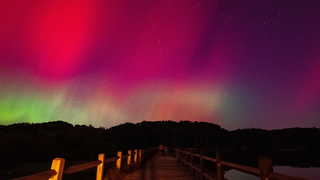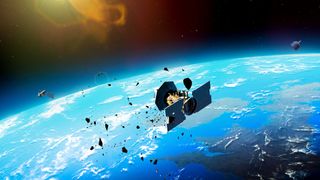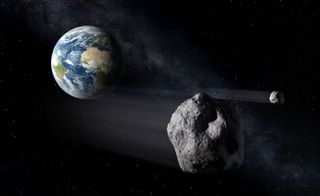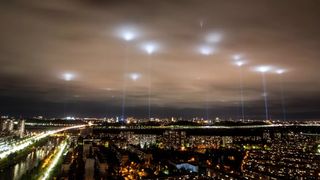Tereza is a London-based science and technology journalist, aspiring fiction writer and amateur gymnast. Originally from Prague, the Czech Republic, she spent the first seven years of her career working as a reporter, script-writer and presenter for various TV programmes of the Czech Public Service Television. She later took a career break to pursue further education and added a Master's in Science from the International Space University, France, to her Bachelor's in Journalism and Master's in Cultural Anthropology from Prague's Charles University. She worked as a reporter at the Engineering and Technology magazine, freelanced for a range of publications including Live Science, Space.com, Professional Engineering, Via Satellite and Space News and served as a maternity cover science editor at the European Space Agency.
Latest articles by Tereza Pultarova

Cosmic rays may be the elusive spark for lightning here on Earth
By Tereza Pultarova published
Cosmic rays may play a role in triggering lightning, a new study suggests, offering an out-of-this-world answer to a long-standing mystery.

Dark skies above world's best astronomy sites could be ruined by new energy project
By Tereza Pultarova published
A green energy plant expected to be built in Chile could increase night-time sky brightness at one of the world's most valuable astronomical sites by up to 35%

Private Starlab space station moves into 'full-scale development' ahead of 2028 launch
By Tereza Pultarova published
The Starlab commercial space station project is moving toward the production phase, having passed a key development milestone with NASA.

How climate change could make Earth's space junk problem even worse
By Tereza Pultarova published
Rising concentrations of greenhouse gases decrease the atmosphere's ability to devour space junk, a new study finds.

Croatia's 1st satellite captures its first views of home (photo)
By Tereza Pultarova published
Croatia's first ever satellite has just beamed to Earth the first image of its homeland.

How much did SpaceX's Starship Flight 7 explosion pollute the atmosphere?
By Tereza Pultarova published
The rapid unscheduled disassembly of SpaceX's Starship mega rocket may have released significant amounts of harmful air-pollution into the upper layers of Earth's atmosphere.

European 'Swarm' satellites detect electric currents from the ocean's tides
By Tereza Pultarova published
Satellites have detected electromagnetic signals generated by ocean tides, suggesting that space-born sensors could obtain insights into the motion of other liquid masses on Earth.

Earth's elusive 'ignorosphere' could shed new light on auroras
By Tereza Pultarova published
Japanese scientists have created the first-ever long-term dataset about Earth's entire atmosphere, stretching all the way to space.

Scientists call on UN to help solve Earth's space junk problem
By Tereza Pultarova published
An international group of researchers is calling on the United Nations to include the protection of Earth's orbit in the U.N.'s sustainable development goals.

World's largest telescope threatened by light pollution from renewable energy project
By Tereza Pultarova published
Astronomers are sounding alarm bells as the world's most precious sky-observing location faces a light pollution risk due to a new renewable energy project.

Major telescope makers hit by class action lawsuit over alleged price fixing
By Tereza Pultarova published
Amateur astronomers who have purchased telescopes from leading suppliers in the U.S. may be entitled to a payment from a class action settlement.

World's 1st wooden satellite deploys from ISS to demonstrate cleaner spacecraft tech (photo)
By Tereza Pultarova published
LignoSat's six-month mission will demonstrate whether wood could help reduce the environmental impact of spaceflight in the future.

Small satellite constellation could reveal black holes like never before
By Tereza Pultarova published
A constellation of small satellites could help researchers view processes in close vicinity of supermassive black holes like never before.

Black holes can squash star formation, James Webb Space Telescope finds
By Tereza Pultarova published
"The Spiderweb protocluster is an ideal laboratory for investigating the relationship between black holes and star formation in detail."

Astronauts on NASA's moon-orbiting Gateway space station will wear smart undershirts to stay healthy
By Tereza Pultarova published
Smart undershirts and AI algorithms will keep astronauts healthy on NASA's planned Gateway moon-orbiting space station.

Car-size asteroid will zip between Earth and the moon tonight
By Tereza Pultarova published
A car-sized asteroid will pass us at about half the distance between Earth and its moon tonight (Dec. 6).

Cosmic rays could help assess hidden war damage in Ukraine
By Tereza Pultarova published
Energetic particles that arise when cosmic rays hit Earth’s atmosphere could help assess hidden damage to buildings in Ukraine after the war.

Satellite survives impact with object in space, takes selfie to prove it (photos)
By Tereza Pultarova published
The 6mm hole was discovered accidentally in footage from an onboard camera.

Astronomers urge FCC to halt satellite megaconstellation launches
By Tereza Pultarova published
Over 100 astronomers from leading U.S. universities have signed an open letter calling for an assessment of potential impacts of satellite megaconstellations on Earth's environment.

Can we solve the satellite air pollution problem? Here are 4 possible fixes
By Tereza Pultarova published
New technologies including recoverable satellites and in-orbit space debris recycling could help solve the satellite air pollution problem and prevent a new ecological crisis in the future.

Debris from satellite breakup threatens other spacecraft, animation shows
By Tereza Pultarova published
Debris from the broken-apart Intelsat 33e telecom satellite is spreading across geosynchronous orbit, threatening spacecraft in this precious region of space, an animation shows.

Breakthrough coming? Iceland could get solar power from space in 2030
By Tereza Pultarova published
A British startup plans to supply solar power from space to Icelanders by 2030, in what could be the world's first demonstration of the novel renewable energy source.

How much do SpaceX's reentering Starlink satellites pollute Earth's atmosphere?
By Tereza Pultarova published
SpaceX's Starlink satellites now make up 40% of reentering satellite debris. But is Elon Musk's space company the worst polluter of Earth's upper atmosphere?
Breaking space news, the latest updates on rocket launches, skywatching events and more!


